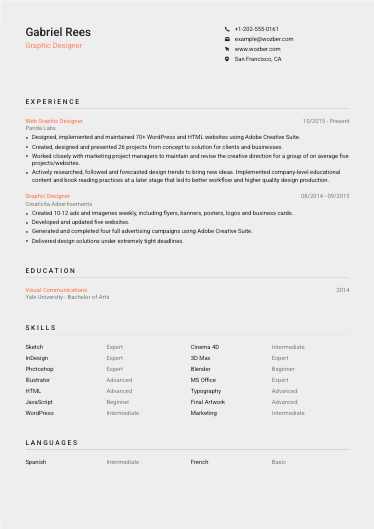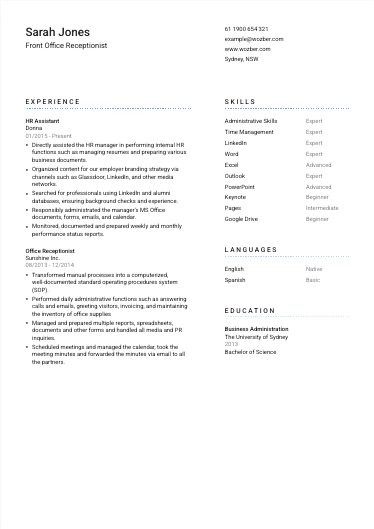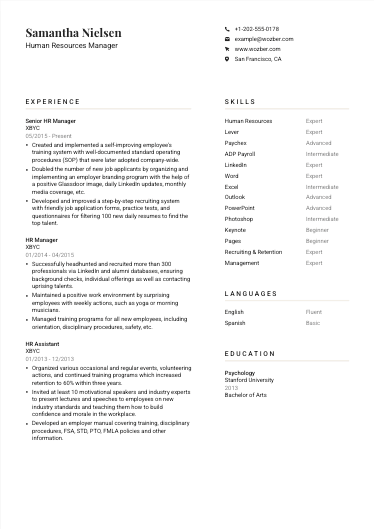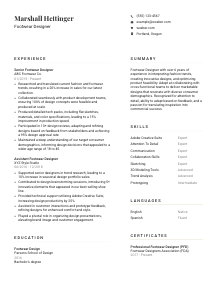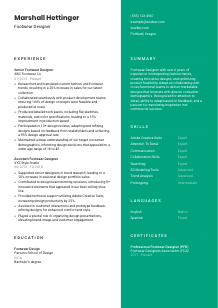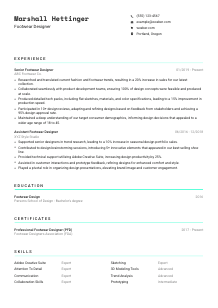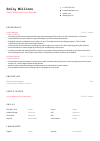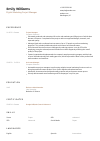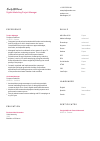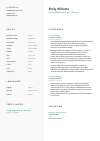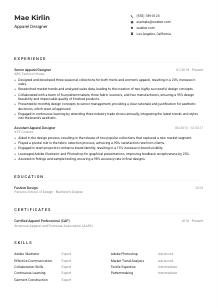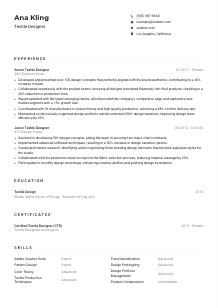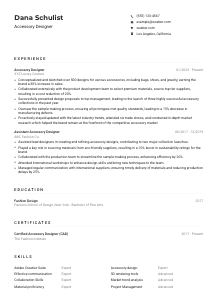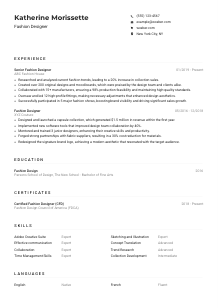Footwear Designer Resume Example
Sketching trendy shoe silhouettes, but your resume feels out of fashion? Step into this Footwear Designer resume example, stylized with Wozber free resume builder. Discover how you can lace your creative flair with job criteria, ensuring your career journey is as sleek and innovative as the kicks you design!
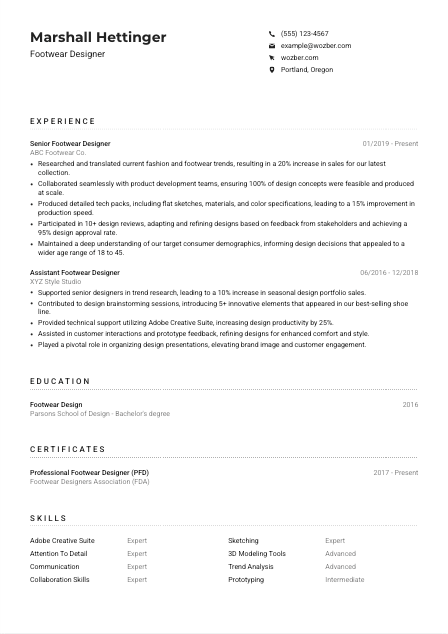
How to write a Footwear Designer Resume?
Welcome, aspiring Footwear Designer! If the world of footwear design excites you and you're looking to step into this creative and rewarding profession with confidence, you're in the right place. This guide, powered by insights and tools from Wozber, a free resume builder, is meticulously designed to help you create a resume that not only passes the ATS scan but also captures the attention of the hiring managers in the footwear design industry. Let's transform your qualifications and experiences into a compelling narrative that lands you that dream Footwear Designer job.
Personal Details
The Personal Details section is the doorway to your resume, giving hiring managers the first glimpse of who you are. For a Footwear Designer, this section requires a bespoke touch to ensure you're stepping right. Below is a curated guide to make your contact information tailor-made for your dream job.
1. Name as Your Brand
In the fashion and design world, your name is your brand. Ensure it's prominently displayed in a clean, stylish font. Think of yourself as designing a logo where your name needs to catch the eye immediately.
2. Job Title Precision
Right beneath your name, subtly stitch your desired job title. This brings clarity and shows your focused intention. Plus, having "Footwear Designer" clearly stated aligns with the job description and starts to weave the narrative of your professional identity.
3. Essential Contact Info
List your most accessible contact number and a professional email address, formatted as firstname.lastname@email.com. This simplicity ensures the focus remains on your qualifications, not deciphering contact details.
4. Embrace Your Locale
The job description specifies Portland, Oregon. By listing this as your location, you're letting the hiring manager know you're already a perfect fit geographically. It's a small detail that speaks volumes about your application's alignment with the job specifics.
5. Professional Profile Add-On
If you have a LinkedIn profile or a personal website showcasing your portfolio, include it. Make sure these profiles are up-to-date and reflect the depth of your work, especially your footwear designs. This is your digital runway; make it stunning.
Takeaway
When you design the personal details section, think of it as the opening of your portfolio. It's sleek, professional, and personalized. Your Personal Details are the handshake before the conversation, setting the stage for the remarkable story that follows. Now, let's lace up and dive into the heart of your resume.





Experience
The Experience section is where your resume truly begins to take shape. Here, you'll illustrate your journey in the footwear design world, highlighting experiences that align with the job's key requirements. Make every bullet point a testament to your passion, skills, and achievements in this dynamic field.
- Researched and translated current fashion and footwear trends, resulting in a 20% increase in sales for our latest collection.
- Collaborated seamlessly with product development teams, ensuring 100% of design concepts were feasible and produced at scale.
- Produced detailed tech packs, including flat sketches, materials, and color specifications, leading to a 15% improvement in production speed.
- Participated in 10+ design reviews, adapting and refining designs based on feedback from stakeholders and achieving a 95% design approval rate.
- Maintained a deep understanding of our target consumer demographics, informing design decisions that appealed to a wider age range of 18 to 45.
- Supported senior designers in trend research, leading to a 10% increase in seasonal design portfolio sales.
- Contributed to design brainstorming sessions, introducing 5+ innovative elements that appeared in our best‑selling shoe line.
- Provided technical support utilizing Adobe Creative Suite, increasing design productivity by 25%.
- Assisted in customer interactions and prototype feedback, refining designs for enhanced comfort and style.
- Played a pivotal role in organizing design presentations, elevating brand image and customer engagement.
1. Break Down the Job Description
Dive into the specifics of the job description, identifying phrases like "research current fashion and footwear trends" and "create detailed tech packs." These are your keywords, the essential patterns you'll align with your experiences.
2. Structure Your Narrative
Chronologically list your roles, beginning with the most recent. For each, include your title, company name, and duration of employment. This creates a clear timeline of your career, inviting the reader to walk through your professional growth.
3. Tailor Your Achievements
Focus on accomplishments that mirror those in the job description. Did you drive a significant increase in sales through your innovative designs? Mention it. Each achievement should reflect your direct contribution to the success of your previous employers, just like our example did.
4. Quantify Your Success
In the world of design, numbers can speak louder than visuals. Whenever possible, quantify your achievements. A "20% increase in sales" or "95% design approval rate" are powerful indicators of your impact.
5. Prioritize Relevance
Remember, not every experience is worth mentioning. Tailor your resume to the Footwear Designer role by focusing on relevant experiences only. This targeted approach keeps your resume sharp and focused, much like your design portfolio.
Takeaway
Think of the Experience section as a carefully curated exhibition of your work. Each role you've held is a gallery showcasing your accomplishments and the value you brought. Tailoring this section to the job requirements is key to proving you're the perfect fit. Now, walk confidently into the spotlight, knowing your experience shines bright.
Education
Your Education section is not just a list of institutions—it's the foundation of your design credentials. Here, you communicate the base upon which your design expertise and creativity are built. Let's ensure this section resonates with the precise requirements for a Footwear Designer.
1. Match the Degree Requirement
The job description calls for a "Bachelor's degree in Footwear Design, Fashion Design, or a related field." Make sure your highest relevant degree is listed prominently to immediately show you meet this foundational requirement.
2. Keep It Structured
Present your education in a simple format: degree, field of study, institution name, and graduation date. This clarity allows hiring managers to quickly verify your educational qualifications against their criteria.
3. Align Your Degree
If your degree directly aligns with the job description, like a Bachelor's in Footwear Design, highlight it. This direct match can significantly bolster your application's standing.
4. Mention Relevant Courses
Including relevant coursework can be particularly valuable if you're early in your career or if the role seeks specialized knowledge. Courses in design theory, material technology, or CAD software are worth mentioning for a Footwear Designer role.
5. Highlight Additional Achievements
If you've received accolades or taken part in notable projects or extracurriculars that underscore your commitment to footwear design, include them. This can add depth to your profile, showcasing a proactive engagement with your field beyond the classroom.
Takeaway
Your education doesn't just testify to your knowledge; it's a narrative of your journey into the footwear design world. It shows your dedication to mastering the craft and your readiness to innovate in this field. With your foundational learning established, let's add more textures and layers to your resume, highlighting your certificates and skills.
Certificates
In the ever-evolving world of footwear design, staying updated with the latest trends, technologies, and techniques is crucial. Certificates can show your commitment to professional growth. Here's how to effectively spotlight this aspect on your resume.
1. Assess the Job's Needs
The job description might not explicitly demand certifications, but including relevant ones can set you apart. Whether it's a certification in Adobe Creative Suite proficiency or a specialized course in 3D modeling, it demonstrates your dedication to excellence and continuous learning.
2. Select Pertinent Certificates
Choose to list certificates that are directly relevant to footwear design or those that elevate your skill set in closely related areas. This ensures that your application resonates with what the hiring team is looking for.
3. Date Your Achievements
If the certificates have a validity period or if they highlight a recent accomplishment, include the date. This shows you're keeping pace with the latest developments in your field.
4. Stay Current
The design industry moves fast; staying at the forefront is essential. Continually seek out certifications and courses that boost your expertise and reflect your commitment to evolving as a designer.
Takeaway
Certificates are the jewels in the crown of your resume, accentuating your commitment to your profession. They validate your ongoing efforts to stay competitive in the dynamic world of footwear design. With your skills and learning credentials polished, let's ensure your toolbox is well-represented in the next section.
Skills
The Skills section of your resume is where you get to really showcase the tools in your design toolkit. For a Footwear Designer, this includes a balance of creative insights, technical prowess, and soft skills essential for collaboration. Here's how to make your skills list as compelling as your designs.
1. Analyze the Job Listing
Start by carefully combing through the job description and noting down skills like "proficiency in design software" or "ability to sketch and render." These are the skills you should highlight in your resume to align with the hiring manager's expectations.
2. Prioritize Relevant Skills
Identify and list skills that are most relevant to the role of a Footwear Designer, focusing on both hard skills like mastery of Adobe Creative Suite and 3D modeling, as well as soft skills like collaboration and communication. Each listed skill is a brushstroke in your skillset portrait.
3. Organize and Optimize
Present your skills in a clean and organized manner, categorizing them if necessary. Remember, your resume might be scanned by an ATS, so using exact keywords from the job description can help ensure your skills section passes the ATS optimization muster.
Takeaway
Think of your skills as the color palette you use to create distinctive designs. They are essential in demonstrating your ability to not only meet the job requirements but excel in them. With your skills clearly outlined, you're painting a picture of a highly competent and creative Footwear Designer. Now, let's proceed to articulate your fluency in the global language of design.
Languages
In the global marketplace of fashion and footwear design, language skills can be a distinctive asset, enhancing your ability to communicate ideas and collaborate across cultures. Here's how to present your linguistic skills in a way that complements your design proficiency.
1. Understand the Role's Requirements
First, ascertain if the job description specifies language requirements. For our Footwear Designer position, being "Proficient in English for customer interactions" is a must. This should be clearly indicated in your resume.
2. Showcase Necessary Languages
Clearly list English as a language in which you are proficient or native. If the role involves international collaboration or market research, demonstrating fluency in other languages can significantly elevate your candidacy.
3. Detail Additional Languages
If you know languages beyond what the job entails, list them too. This displays your versatility and readiness to engage in a globalized work environment, making you a more attractive candidate for roles that value cultural diversity.
4. Be Honest About Your Proficiency
Accurately describe your level of fluency for each language. Whether you're native, fluent, intermediate, or possess basic proficiency, being transparent about your language skills prevents misunderstandings and sets clear expectations.
5. Leverage the Power of Diversity
In the creative industries, linguistic diversity can be a powerful tool, allowing for richer collaborations and a broader understanding of global trends. Highlighting your language skills can underscore your capacity to contribute to diverse teams and projects.
Takeaway
Languages are more than just words; they are the channels through which creativity and collaboration flow. Listing them on your resume showcases not just your ability to communicate but also your potential to be a bridge in an increasingly interconnected world of design. With your linguistic skills clearly outlined, let's distill the essence of your professional narrative in the summary section.
Summary
The Summary section offers a snapshot of your professional identity, encapsulating your design philosophy, core skills, and significant achievements. For a Footwear Designer, this is your moment to communicate the essence of your creativity and expertise. Let's craft a summary that's as compelling as your designs.
1. Reflect on the Core of the Job
Begin by internalizing the job description. Understand not just the skills required but the ethos of the brand or company you're applying to. Think about how your design sensibility aligns with their values and product line.
2. Start with Your Narrative
Introduce yourself as a professional in the first few lines. Convey your specialization and experience level, e.g., "Footwear Designer with over 6 years of experience in translating fashion trends into innovative designs." This sets the tone for your professional story.
3. Highlight Matching Skills and Achievements
Enumerate key skills and accomplishments in a succinct manner. Focus on those that directly align with the job description, like your proficiency in design software or your ability to drive sales through creative designs. This reinforces your fit for the role.
4. Keep It Concise and Impactful
Your summary should be a teaser, not the full story. Aim for 3-5 compelling lines that invite the hiring manager to dive deeper into your resume. Think of it as the elevator pitch for your career in footwear design.
Takeaway
Crafting an engaging summary is like designing the perfect shoe; it requires balance, focus, and an understanding of the wearer (in this case, the hiring manager). With your summary finely tuned to highlight your strengths and alignment with the role, you've set a strong foundation for your application. Your resume is now a polished representation of your journey and ambitions as a Footwear Designer. Let Wozber free resume builder, complete with ATS-friendly resume templates and an ATS resume scanner, be your tool in crafting this important document. Your path to a rewarding Footwear Designer role is paved with creativity and precision; let your resume reflect just that. Step forward with confidence—the design world awaits your unique contributions.
Launching Your Footwear Designer Journey
Congratulations on completing this comprehensive guide to creating an outstanding Footwear Designer resume. With each section carefully tailored to reflect your expertise and enthusiasm for footwear design, you're ready to step into the spotlight. Remember, the journey to your dream role is both a creative and strategic endeavor. Use Wozber, with its free resume builder, ATS-friendly resume template, and ATS resume scanner, as your ally in navigating the application process. Embrace the journey with passion, precision, and persistence.
The fashion industry is ripe with opportunities for those who dare to dream big and design boldly. Your next masterpiece awaits. Let's make your mark in the world of footwear design!

- Bachelor's degree in Footwear Design, Fashion Design, or a related field.
- Minimum of 3 years' experience in footwear design or a related industry.
- Strong proficiency in design software such as Adobe Creative Suite and 3D modeling tools.
- Ability to sketch, render, and present design concepts with attention to detail.
- Excellent communication and collaboration skills to work with cross-functional teams.
- Proficient in English for customer interactions.
- Must be located in Portland, Oregon.
- Research current fashion and footwear trends, and translate them into innovative and marketable designs.
- Collaborate with product development teams to ensure design concepts are feasible and can be produced at scale.
- Create detailed tech packs, including flat sketches, materials, and color specifications for production.
- Participate in design reviews and adapt designs based on feedback from stakeholders.
- Maintain an understanding of target consumer demographics to inform design decisions.

